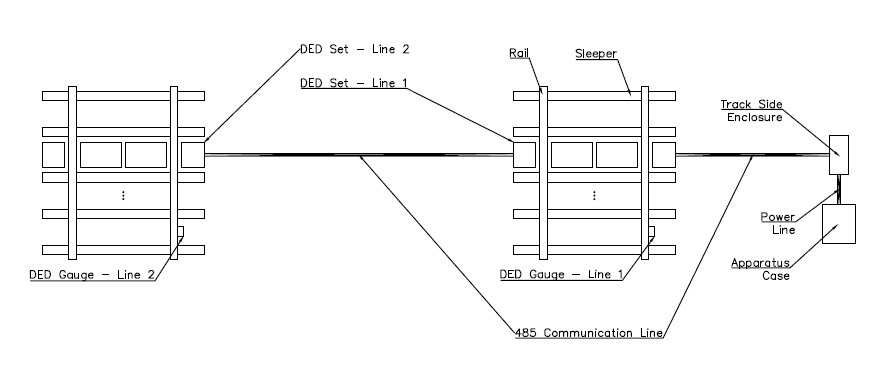
Dragging Equipment Detector (DED) Technology is deployed to actively detect and alert users to objects dragging from passing trains. A variety of objects are typically secured at or near the underside of a train and may become loose or partially detached from the train in some situations. For example, the vibration of the train travelling along the track may cause an air hose, a pipe or other object to drag beneath the train. This dragging equipment can damage the rail infrastructure and present a hazard to infrastructure equipment, e.g. points, sleepers, crossings and in extreme cases, result in derailment. To make matters worse, train drivers would likely be unaware that the train is causing extensive damage as it moves along.
The impactor-style DED was designed to alleviate the problems associated with the traditional paddle-style system. The stationary impact plates that are situated between and outboard of the rails are fitted with sensors that detect impact energy. An alarm be will generated if the impact is sufficiently large. In combination, the impact must be time-matched to a wheel set, through a wheel sensor interface – this eliminates the possibility of false alarms.
Product Features and Highlights
Stationary Impact Plates vs. Traditional Paddle Set
The impact-style DED was designed to alleviate the problems associated with the traditional paddle-style system. The stationary impact plates, situated between and outboard of the rail legs, are fitted with sensors that detect impact energy. An alarm is generated if the energy is sufficiently large and the analogue nature of the sensors allows for configurable detection levels. The traditional paddle set, however, provides only an on or off signal, with no configurable detection level.

Individual Plates Allow Position of Impact to be Reported
Each DED system contains four independent impact plates. One pair of plates is located either side of the left rail leg and a similar pair of plates are positioned on either side of the right leg, as shown in the image below. This layout allows identification of the lateral position of the detected impact, simplifying the task of locating the offending object.
In combination, the impact has to be time-matched to a wheel set, through a wheel sensor interface, eliminating the possibility of false alarms.
The plates are designed to accommodate wheels and rail clips.

Integrated Wheel Sensor Interface to Pinpoint Impact
The DED system makes use of vertical load receptors, which behave as wheel sensors. The main function of these wheel sensors is for indexing impacts to axles. This means that impacts are matched to the nearest axle within the vehicle and train as a whole, greatly simplifying the process of locating the offending object.
The sensors also assist in vehicle footprint recognition, allowing positive identification of locomotives and wagons. This ensures accurate consist identification.
Finally, the sensors also provide stoppage and reversal support, ensuring data integrity should these events occur.

Configurable Alert Levels
The analogue nature of the sensors allows for configurable detection levels. Three levels are provided for, allowing differentiation of impacts by severity and required action.
Microprocessor-Based System
Based entirely on microprocessors, the DED system is energy-efficient and reliable, while providing excellent performance. All components are industrial and solid-state, with no moving or rotating parts. Dedicated firmware removes the need for an Operating System, increasing stability while reducing costs and maintenance requirements. The result is a simpler, more reliable system, which is ideal for harsh operating environments.
The hardware is compact, resulting in a much smaller footprint than traditional systems. All T-series products and variants are housed in a small, vandal-proof 500×400 mm trackside enclosure. The enclosure is easily installed by a small team and does not require a large foundation to be laid.
The low-power requirement of the system makes solar powering an option, with a typical current draw of 500mA at 12V. This makes the DED system ideal for remote locations and provides great flexibility on where the equipment can be installed.

Configurations
In cases where two lines are to be monitored, two DED systems are installed in one enclosure, making use of a single power source – mains or solar.
Communications
The DED system provides native support for GSM-based and Ethernet communications. The GSM modem used is a plug-in module with options available to cater for various frequency bands in use around the world.
GSM network support makes the system ideal for remote installations, as it makes use of existing GSM communications networks. Three antenna options are also available, providing standard, high and very-high gain options, providing a solution for even the weakest of signals.
Transmitted data is a compressed binary stream, ensuring that communication resources are used sparingly. This approach puts the communication payload in the realm of bytes rather than kilobytes or megabytes with traditional monitoring systems.
The combination of efficient data usage and GSM support makes the DED system ideal for remote installation.
Reporting
Alarm Content
For each detected impact, the following information is produced:
- Site identifier
- Date and time of detected impact
- Direction of travel
- Vehicle speed
- Vehicle type (wagon or locomotive)
- Impact position (inside left / outside left / outside right / inside right)
- Axle number in train
- Axle number in vehicle
- Vehicle number in train
Post-Train Summary Content
After each train movement, the following information is produced:
- Site identifier
- Date and time of train event
- Direction of travel
- Number of vehicles detected
- Number of axles detected
- Number of alerts detected
- Event outcome: normal or stoppage/reversal events
Site Layout


Installation Requirements
- Installation requires approximately 8 hours for a double-line site.
- Straight, level section of track required.
- Power required (220V AC / 24V DC / 12V DC).
- No cutting of the track.
- No sleeper modification.
